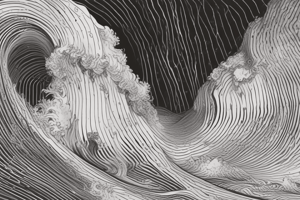Podcast
Questions and Answers
The frequency of a sound can be described as high pitched or low pitched.
The frequency of a sound can be described as high pitched or low pitched.
True (A)
The intensity of a sound can be described as soft or medium.
The intensity of a sound can be described as soft or medium.
False (B)
The duration of a sound can be described as rapid or slow.
The duration of a sound can be described as rapid or slow.
False (B)
Sound can propagate through air and materials.
Sound can propagate through air and materials.
The sound is transformed into electrical impulses in the eardrum.
The sound is transformed into electrical impulses in the eardrum.
You can hear your interlocutor speaking from a distance as long as the wire is loose.
You can hear your interlocutor speaking from a distance as long as the wire is loose.
The vibration of a sound propagates through water in the same way as in the air.
The vibration of a sound propagates through water in the same way as in the air.
Low sounds have a short and repeated wave.
Low sounds have a short and repeated wave.
You can make a sound weaker by pinching the phone wire.
You can make a sound weaker by pinching the phone wire.
The movement of the candle's flame is observed when it is far from the speaker.
The movement of the candle's flame is observed when it is far from the speaker.
Sound is not a kind of vibration.
Sound is not a kind of vibration.
Grains of salt and pepper do not move on the cellophane membrane.
Grains of salt and pepper do not move on the cellophane membrane.
You can amplify a sound by enclosing the sound source in a closed container.
You can amplify a sound by enclosing the sound source in a closed container.
What is the result of sound vibrations on the eardrum?
What is the result of sound vibrations on the eardrum?
What is the main factor that determines the pitch of a sound?
What is the main factor that determines the pitch of a sound?
What is the role of the auditory nerve in the process of hearing?
What is the role of the auditory nerve in the process of hearing?
What is the source of sound?
What is the source of sound?
What can affect the timbre of a sound?
What can affect the timbre of a sound?
What happens to the grains of salt and pepper on the cellophane membrane?
What happens to the grains of salt and pepper on the cellophane membrane?
What is the role of the wire in the telephone of cups experiment?
What is the role of the wire in the telephone of cups experiment?
What happens to the candle's flame when the speaker is nearby?
What happens to the candle's flame when the speaker is nearby?
How does the sound propagate in water compared to air?
How does the sound propagate in water compared to air?
What can you do to make a sound louder?
What can you do to make a sound louder?
What is a characteristic of high sounds?
What is a characteristic of high sounds?
What is a characteristic of low sounds?
What is a characteristic of low sounds?
What is the result of placing your hands on your throat and chest when speaking?
What is the result of placing your hands on your throat and chest when speaking?
What is the characteristic of a sound with high frequency?
What is the characteristic of a sound with high frequency?
What happens to the sound when it reaches the eardrum?
What happens to the sound when it reaches the eardrum?
What is necessary for sound to propagate?
What is necessary for sound to propagate?
What is the role of the auditory nerve in the process of hearing?
What is the role of the auditory nerve in the process of hearing?
What can affect the timbre of a sound?
What can affect the timbre of a sound?
What is a sound?
What is a sound?
What happens when you place your hands on your throat and chest when speaking?
What happens when you place your hands on your throat and chest when speaking?
What do you observe in Experiment 2: Salt and pepper on a membrane?
What do you observe in Experiment 2: Salt and pepper on a membrane?
Why can you hear your interlocutor speaking from a distance in the telephone of cups experiment?
Why can you hear your interlocutor speaking from a distance in the telephone of cups experiment?
What is the difference between high and low sounds?
What is the difference between high and low sounds?
How can you make a sound louder or weaker?
How can you make a sound louder or weaker?
What happens to the sound in Experiment 5: The cellphone in the box?
What happens to the sound in Experiment 5: The cellphone in the box?
How does the sound propagate in water compared to air?
How does the sound propagate in water compared to air?
Flashcards are hidden until you start studying
Study Notes
Sound and Vibration
- A sound is a vibration that can be felt in our body, as demonstrated by placing hands on the throat and chest when speaking.
- Sound can be observed through the movement of objects, such as salt and pepper grains on a membrane, a candle flame, and a telephone wire.
Propagation of Sound
- Sound vibrations propagate through the air and make other objects vibrate.
- Sound can propagate through water, but not in the same way as in the air.
- The vibration of sound can be blocked or hindered by certain materials, such as plastic.
Characteristics of Sound
- Sound can be low-pitched (grave) or high-pitched (aigu).
- Low sounds have longer and more spread-out waves, while high sounds have shorter and more repeated waves.
- Sound can be loud (fort) or weak (faible), and its intensity can be amplified or attenuated.
- Sound can also be modified in terms of frequency, duration, and timbre (speed).
Sound Production and Perception
- Sound is produced by a source, such as a speaker, and makes the eardrum (tympan) vibrate.
- The vibration is transformed into electrical impulses and sent through the auditory nerve (nerf auditif).
- The sound is then decoded and understood in the brain.
Sound and Vibration
- A sound is a vibration that can be felt in our body, as demonstrated by placing hands on the throat and chest when speaking.
- Sound can be observed through the movement of objects, such as salt and pepper grains on a membrane, a candle flame, and a telephone wire.
Propagation of Sound
- Sound vibrations propagate through the air and make other objects vibrate.
- Sound can propagate through water, but not in the same way as in the air.
- The vibration of sound can be blocked or hindered by certain materials, such as plastic.
Characteristics of Sound
- Sound can be low-pitched (grave) or high-pitched (aigu).
- Low sounds have longer and more spread-out waves, while high sounds have shorter and more repeated waves.
- Sound can be loud (fort) or weak (faible), and its intensity can be amplified or attenuated.
- Sound can also be modified in terms of frequency, duration, and timbre (speed).
Sound Production and Perception
- Sound is produced by a source, such as a speaker, and makes the eardrum (tympan) vibrate.
- The vibration is transformed into electrical impulses and sent through the auditory nerve (nerf auditif).
- The sound is then decoded and understood in the brain.
Sound and Vibration
- A sound is a vibration that can be felt in our body, as demonstrated by placing hands on the throat and chest when speaking.
- Sound can be observed through the movement of objects, such as salt and pepper grains on a membrane, a candle flame, and a telephone wire.
Propagation of Sound
- Sound vibrations propagate through the air and make other objects vibrate.
- Sound can propagate through water, but not in the same way as in the air.
- The vibration of sound can be blocked or hindered by certain materials, such as plastic.
Characteristics of Sound
- Sound can be low-pitched (grave) or high-pitched (aigu).
- Low sounds have longer and more spread-out waves, while high sounds have shorter and more repeated waves.
- Sound can be loud (fort) or weak (faible), and its intensity can be amplified or attenuated.
- Sound can also be modified in terms of frequency, duration, and timbre (speed).
Sound Production and Perception
- Sound is produced by a source, such as a speaker, and makes the eardrum (tympan) vibrate.
- The vibration is transformed into electrical impulses and sent through the auditory nerve (nerf auditif).
- The sound is then decoded and understood in the brain.
Studying That Suits You
Use AI to generate personalized quizzes and flashcards to suit your learning preferences.




